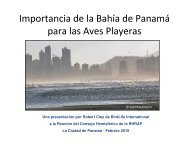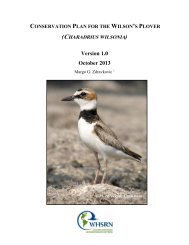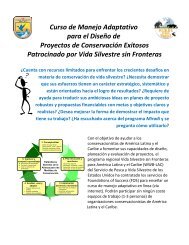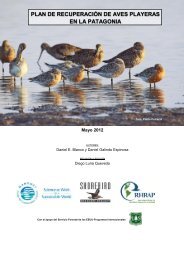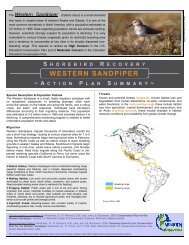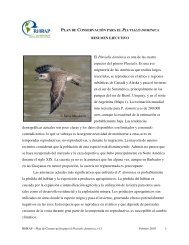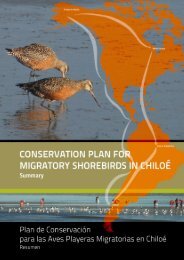Sanderling Plan - Western Hemisphere Shorebird Reserve Network
Sanderling Plan - Western Hemisphere Shorebird Reserve Network
Sanderling Plan - Western Hemisphere Shorebird Reserve Network
Create successful ePaper yourself
Turn your PDF publications into a flip-book with our unique Google optimized e-Paper software.
Tabilo et al. 1996, MacWhirter et al. 2002), as well as in the Guianas (Morrison and Ross 1989).<br />
Sublethal effects of these agricultural and urban pollutants (including organochlorines,<br />
organophosphorus insecticides, heavy metals, and plastics), have not been studied. Contaminants<br />
may be a serious threat to <strong>Sanderling</strong>s wherever concentrations are high or persistent.<br />
Industrial and agricultural contaminants in food sources may be especially dangerous to<br />
shorebirds. As the fat from these food sources is burned during migratory flights, the<br />
contaminants are released in high doses. This potentially reduces a bird’s ability to refuel or to<br />
escape predators at a subsequent stopover site. (Butler et al. 2004).<br />
Disease<br />
Diseases may play an important role in influencing population trends of the <strong>Sanderling</strong>.<br />
Increasingly, water quality and quantity have become an issue at shallow lakes in the Canadian<br />
Prairies region and the United States (Great Lakes). The frequency and intensity of toxic<br />
outbreaks (e.g., avian botulism) has increased in recent years, presumably due to warmer water<br />
temperatures (global climate change) and shallower waters (water manipulation for agriculture,<br />
or extended drought-like conditions concurrent with global warming).<br />
Avian botulism outbreaks cause widespread die-offs of waterbirds, claiming tens of<br />
thousands of shorebirds (Strauman 1996), among many other species. Although historical<br />
records of avian botulism outbreaks are very common, specific information on shorebird die-offs<br />
from these events is limited because shorebirds are rarely identified to species.<br />
Some of the shallow lakes that serve as major staging areas for the <strong>Sanderling</strong> in spring<br />
have experienced increased rates of botulism (Adams et al. 2003) and associated waterbird<br />
mortalities. However, at present, most botulism outbreaks occur during the fall migration period<br />
(and at select wetlands), at a time of year when <strong>Sanderling</strong>s are more dispersed.<br />
CLIMATE CHANGE<br />
It is important to include a section on climate change in this plan despite uncertainties<br />
around potential climate change impacts. The reasons are twofold: 1) climate change is here;<br />
current levels of carbon dioxide in the atmosphere will continue to influence the climate (and<br />
landscape) for decades, even as new policies are put into place to reduce new inputs; and 2) in<br />
many cases, climate change will not manifest itself as a new and independent management<br />
WHSRN – <strong>Sanderling</strong> Conservation <strong>Plan</strong>, February 2010, v1.1 43




